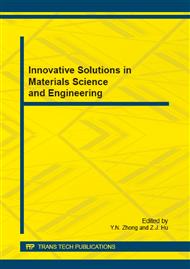p.27
p.31
p.35
p.41
p.46
p.51
p.57
p.62
p.67
Research on Effect of Cr3C2 Addition on Microstructure and Mechanical Properties of Ti(C,N)-Based Cermets
Abstract:
Four Ti (C,N)-based cermets with Cr3C2 content of 0.3%, 0.6%, 0.9% and 1.2 % in mass ratio were sintered in vacuum at 1430oC, 1450oC, 1465oC and 1480oC. The mechanical properties of the specimens were determinted and microstructures were observed using the scanning electron microscope (SEM) to study the effect of Cr3C2 content on mechanical properties and microstructure. The results show that the four Ti (C,N)-based cermets sintered at 1465oC have the best overall mechanical properties; and among them, the cermet with 0.6% Cr3C2 has the best overall mechanical properties, i.e. transverse rupture strength (TRS) 1967MPa, hardness 1556HV and fracture toughness (KIC) 9.5MPa.m1/2. With the increase of Cr3C2 content, the black core volume fraction firstly increases and then decreases, the white core decreases in a progressive and continuous manner, the rim phase firstly increases and then decreases, the binder phase firstly decreases and then increases.
Info:
Periodical:
Pages:
46-50
Citation:
Online since:
November 2014
Authors:
Price:
Сopyright:
© 2015 Trans Tech Publications Ltd. All Rights Reserved
Share:
Citation:


